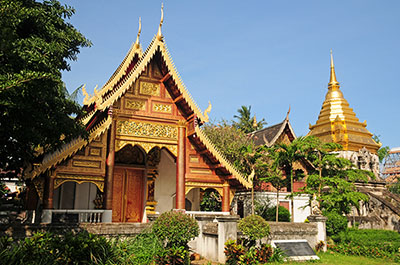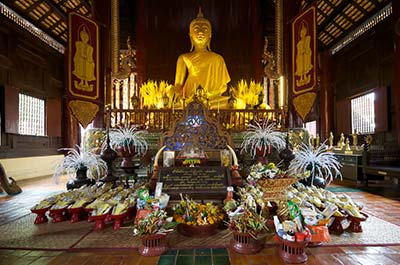
Wat Dubphai
The temple that can end suffering
Chiang Mai
Wat Dubphai, also known as Wat Dab Pai, a small temple near the North West corner of the old walled town of Chiang Mai comprises of a viharn, an ubosot, a chedi and a bell tower.
Guarding the entrance gate is a pair of white and gold Chinthe, mythological lion like creatures often found in Burmese temples.
Legend of the Buddha image that can end suffering
According to local belief paying homage at the temple can end people’s suffering. Local legend tells centuries ago there was a man who fell seriously ill. He prayed to a Buddha image named Phra Chao Dab Pai asking for his recovery. When he recovered he built the Wat Dubphai and named it after the image.
Viharn
The Wat Dubphai’s viharn or assembly hall is a large Lanna style building with a two tiered roof. Naga heads adorn the ends of the intricately decorated golden barge boards. Extending over the balustrades of the stairway are ferocious looking white and gold Naga serpents. The ornate gable is adorned with colorful flower motifs in Lanna style.

The roof is supported by red columns adorned with elaborate golden motifs. Colorful murals adorn the walls. Over the entrance door is a depiction of “the four signs” that made Prince Siddhartha Gautama decide to become an ascetic and ultimately the Buddha, the four signs being a sick man, a dying man, a dead man and an ascetic.
Seated on a raised pedestal is the temple’s principal Buddha image, a large golden image in subduing Mara posture, behind it a mural of a Bodhi tree in a tranquil, natural landscape.
Chedi
Behind the viharn, enclosed by a fence stands the temple’s chedi. Resting on a square base with indented corners and an octagonal section of several tiers receding in size is the bell topped with a multi tiered hti, a ceremonial umbrella. Around the fence are several smaller chedis.
Ubosot
The ubosot or ordination hall is guarded by a pair of mythological Naga serpents, their bodies extending over the balustrades of the stairway. Lanna style gold on light blue flower motifs adorn the front gable, while colorful murals depict Buddhist stories on the porch.
Seated on a high and elaborate pedestal is a Buddha image in subduing Mara posture. On the wall behind is a mural of a peaceful scene of nature and a large Bodhi tree, the tree the Buddha meditated under when reaching enlightenment.
Murals
Murals on the side walls depict important events in the life of the Buddha. One of them shows the Buddha meditating under the Bodhi tree when Mara and his armies attack, trying to stop the Buddha from meditating. Phra Mae Thorani, the Earth Goddess of Buddhism, is seen wringing out the waters out of her long hair, thereby drowning the armies of Mara.
Another mural shows the Buddha’s descend from Tavatimsa Heaven awaited by a large crowd of devotees.

How to get to Wat Dubphai
The temple is found in the North West corner of the old walled town of Chiang Mai. It is located on Singharat road near the intersection with Singharat Soi 3, about 400 meters North of the Wat Phra Singh.
Opening hours
The Wat Dubphai opens daily during daylight hours.
Entrance fee
Admission is free.

